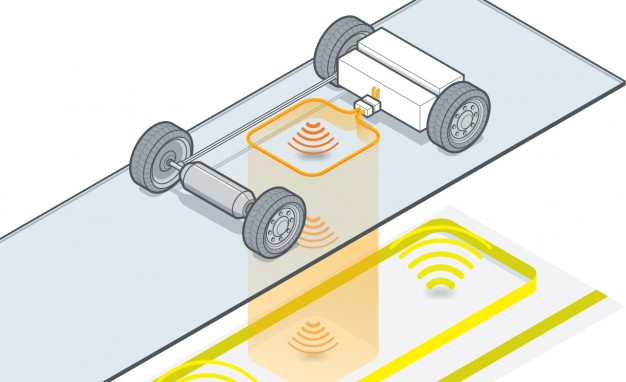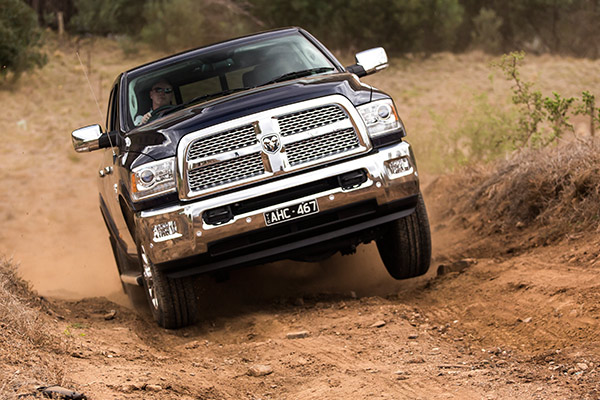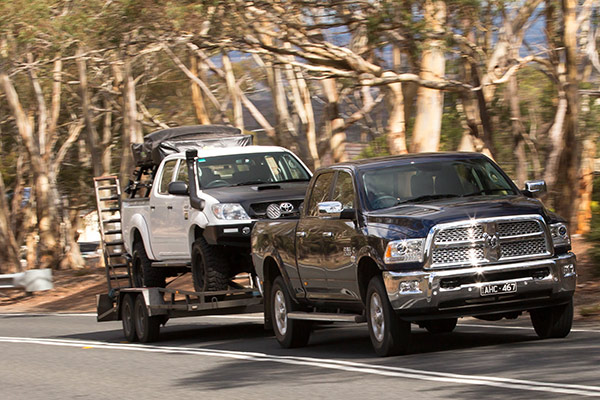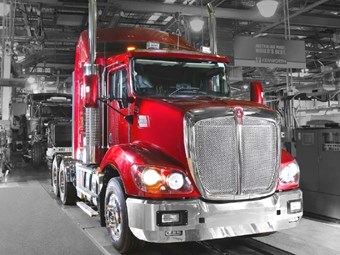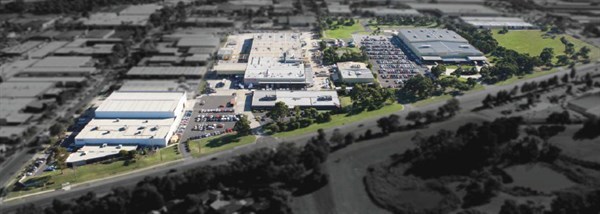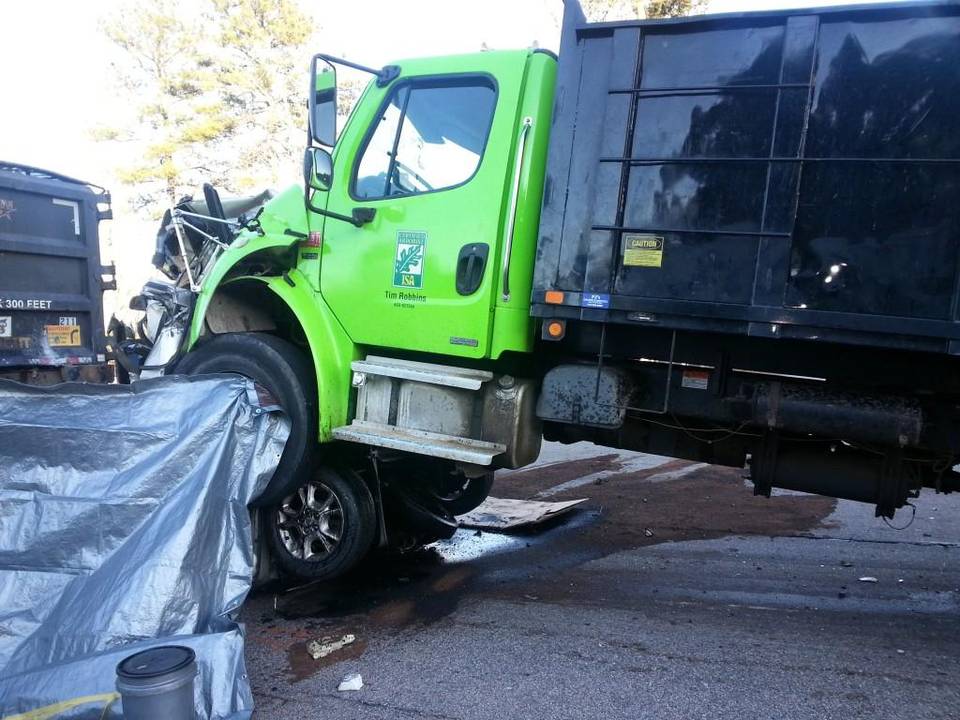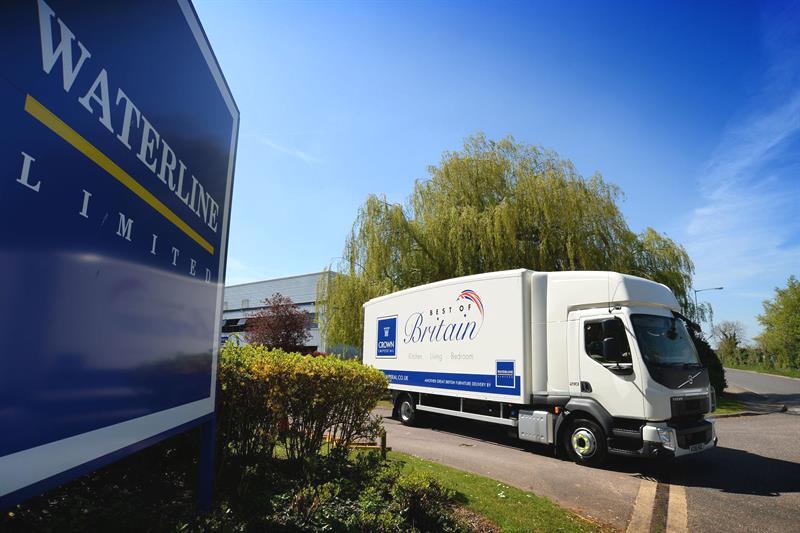
kscarbel2
Moderator-
Posts
17,891 -
Joined
-
Days Won
86
Content Type
Profiles
Forums
Gallery
Events
Blogs
BMT Wiki
Collections
Store
Everything posted by kscarbel2
-
Transport Topics / May 31, 2016 Daimler Trucks North America is now offering the Hadley SmartValve electronic height control system as an option on new trucks. SmartValve, introduced as a retrofit system in 2013, is designed to make drop-and-hook operations faster, easier and safer. It reduces back strain and injuries for the driver, who doesn’t need to struggle against the weight of the trailer when cranking landing gear, the company said. “The Hadley SmartValve was developed to enhance driver comfort and safety,” Jim Green, president of Hadley, said in a statement. “For the fleet owners the cost savings and driver satisfaction are an added bonus.” .
-
Transport Topics / May 31, 2016 The ongoing battle between Rhode Island Gov. Gina Raimondo and the state’s trucking association took another turn on May 27 when Vice President Joe Biden flew to the Ocean State to publicly express his support for RhodeWorks, Raimondo’s truck-only tolling infrastructure plan. “Gov, you took a lot of heat … but you got the bill passed … to provide $850 million to modernize your infrastructure and make your state more competitive,” Biden told a gathering at the Rhode Island Department of Transportation’s facility in East Providence. “And you found a funding source. Every other state, except Connecticut, in the Northeast Corridor levies a toll on large commercial vehicles rolling through their states. That’s not because they go looking for an easy target. They do the most damage. They’re heavy. … We need the trucking industry. We need it badly, but it can afford to pay the toll because it’s supposed to be proportionate.” Chris Maxwell, CEO of the Rhode Island Trucking Association, doesn’t see it that way. “Vice President Biden’s endorsement of RhodeWorks, while not surprising, leads us to wonder how an administration that espouses non-discrimination and societal shared burdens could support the discriminatory tolling of one sector to shoulder 100% of the infrastructure burden,” Maxwell said. “Contrary to Mr. Biden’s chiding comment that ‘they can afford it,’ Rhode Island’s trucking industry, its business owners and its consumers can ill-afford the effects of truck-only tolling.” Biden, who was joined for his speech by Raimondo and Rhode Island’s four-member congressional delegation, had earlier examined the East Shore Expressway Bridge, which has been partly held up for 10 years by wooden beams he termed “Lincoln Logs” and “shameful.” The bridge, which trucks weighing more than 17 tons are prohibited from using, is a reason why Rhode Island leads the nation with 21% of its bridges considered structurally deficient. As the Federal Highway Administration considers whether to approve RhodeWorks, Biden praised Raimondo as “one of the few governors to step up and lead [on infrastructure]. I wish every governor understood the opportunities that come with modernizing infrastructure. ... Companies are not going to stay in states unless they can cheaply, efficiently and safely get their products out to the global market. … That’s why it’s so critical what your governor and your Legislature [are] doing. … It’s about economic dynamism, competitiveness, productivity and safety. It’s about the kind of country we want to be. Your governor gets it in her bones.”
-
Volvo Trucks’ new concept truck cuts fuel consumption by more than 30% Green Car Congress / May 31, 2016 With support from the Swedish Energy Agency, Volvo Trucks has developed a new concept vehicle, the Volvo Concept Truck. The result of a five-year long research project aimed at creating more energy-efficient vehicles, the new concept truck cuts fuel consumption by more than 30%. The aim of the project is to improve the efficiency for long-haul truck transportation by 50%. One of the key factors behind the low fuel consumption is the massive 40% improvement in aerodynamic efficiency that has benefited both the tractor and trailer. Aerodynamically optimized chassis side-skirts cover the rear wheels on the tractor and all the trailer wheels; aerodynamic spoilers extend the trailer and cut air resistance. “We’ve modified the entire rig and optimized it for improved aerodynamics as much as possible. For instance, we use cameras instead of rear-view mirrors. This cuts air resistance, so less energy is needed to propel the truck,” says Åke Othzen, Chief Project Manager at Volvo Trucks. In addition to the aerodynamic improvements, the concept vehicle is fitted with newly developed tires with lower rolling resistance. The trailer weighs two tonnes less than the reference trailer, which translates into either lower fuel consumption or the possibility of higher payload. The project also includes an improved driveline. The rig was test driven on Swedish roads in autumn 2015. Since the concept vehicle is part of a research project it will not be available on the market. However, some of its aerodynamic features have already been implemented on Volvo Trucks' series-produced vehicles, and more of its solutions may be fitted in the future. The research project is a bilateral joint venture between Sweden and the US involving support from the Swedish Energy Agency and the US Department of Energy. The US SuperTruck project aims to increase transport efficiency for long-haul operations on the North American market.
-
Volvo Trucks Global Press Release / May 31, 2016 Almost one-third lower fuel consumption. Volvo Trucks’ new concept vehicle shows how it is possible to drastically boost productivity in long-haul operations. Among the secrets behind these remarkable fuel savings are aerodynamic design and lower kerb weight. With support from the Swedish Energy Agency, Volvo Trucks has developed a new concept vehicle, the Volvo Concept Truck. It is the result of a five year long research project aimed at creating more energy-efficient vehicles. The new concept truck cuts fuel consumption by more than 30 %. "We continuously work on developing more energy-efficient vehicles. This is a high-priority area both out of environmental concern and in order to reduce our customers' costs. We're proud to be able to drive this development. Our concept truck showcases the immense power of on-going technical advances," says Claes Nilsson, President and CEO Volvo Trucks. One of the key factors behind the low fuel consumption is the massive 40 % improvement in aerodynamic efficiency that has benefited both the tractor and trailer. "We've modified the entire rig and optimised it for improved aerodynamics as much as possible. For instance, we use cameras instead of rear-view mirrors. This cuts air resistance, so less energy is needed to propel the truck," explains Åke Othzen, Chief Project Manager at Volvo Trucks. In addition to the aerodynamic improvements, the concept vehicle is fitted with newly developed tyres with lower rolling resistance. The trailer weighs two tonnes less than the reference trailer, which translates into either lower fuel consumption or the possibility of higher payload. The project also includes an improved driveline. The rig was test driven on Swedish roads in autumn 2015. Work on the Volvo Concept Truck has been in progress since 2011. The aim is to improve the efficiency for long-haul truck transportation by 50 %. Since the concept vehicle is part of a research project it will not be available on the market. However, some of its aerodynamic features have already been implemented on Volvo Trucks' series-produced vehicles, and more of its solutions may be fitted in the future. Facts: Volvo Concept Truck The research project is a bilateral joint venture between Sweden and the USA involving support from the Swedish Energy Agency and the U.S. Department of Energy. The American SuperTruck project aims to increase transport efficiency for long-haul operations on the North American market. Specifications: Volvo Concept Truck Truck model: Volvo FH 420 Engine: Volvo D13 Euro 6 Facts: The aerodynamic improvements - Optimised aerodynamic trailer and tractor. - In order to reduce air resistance, the conventional rear-view mirrors have been replaced by cameras, which have the added advantage of offering better visibility and increased safety. - Aerodynamically optimised chassis side-skirts cover the rear wheels on the tractor and all the trailer wheels. - Aerodynamic spoilers extend the trailer and cut air resistance. - Optimised air flow for the engine's cooling system - Minimised air resistance at the front of the tractor, the wheel housings and entry steps. .
-
Car & Driver / May 31, 2016 Saving the environment can be exhausting, especially if you own an electric vehicle that requires you to physically plug and unplug the charger into and out of the charging port. Fortunately, wireless charging for your electric or plug-in hybrid vehicle is all but certain to become ubiquitous, and the automotive-engineering organization SAE International is currently working on creating a standard for these charging systems. First presented at the Conference on Electric Roads and Vehicles (CERV) in Logan, Utah, in mid-May, but published today, SAE TIR J2954 lays out this groundwork in the name of consumer safety and convenience. Calling for a common frequency band of 85 kHz (81.39–90.00 kHz), SAE is proposing four classes of wireless power transfer levels that result in slower or faster charge times: 3.7 kW, 7.7 kW, 11.0 kW, and 22.0 kW. SAE notes that additional, quicker power transfer levels may be added in future iterations of the standard. Because the SAE standard will encourage the vehicle industry to design wireless charging systems around a set frequency band, consumers will be able to charge their electric vehicles wirelessly at any number of locations without worrying that a specific wireless charging station won’t be compatible with their car or truck. Although the standard has been written to create a norm for stationary wireless charging systems, SAE is looking toward the future and acknowledges within the published document that it is open to creating standards for wireless charging systems that work while the vehicle is in motion. .
-
Wait a minute.....I'm having a flashback. Does your seal have an outer diameter or 4 inches, or 4-1/4 inches ? If it's 4-1/4", you need a 446GC181 (Which I'm sure that revered caped crusader "Mack Man ".....err Barry can provide you) If it's 4" (probably not), your original part number 446GC316 superceded to 446GC1115.
-
The Mack front crankshaft oil seal is a 446GC1115. I'm sure that Barry can fix you right up.
-
Paccar factory tour Take a look inside Paccar's Bayswater factory in Melbourne, the home of Kenworth Slide Show - http://www.bigrigs.com.au/photos/paccar-factory-tour/40398/#/0
-
Place pillows on the floor around you. Open this link - http://www.ramtrucks.com/en/#app-bmo Then click on "Build & Price" For a zip code, use 18103 (Allentown, PA)
-
Trade Trucks.com.au / May 28, 2016 The ASV RAM barged onto the Australian market in late 2015. The Mopar pick-up doesn’t seem to make as much of a bling statement as it’s Ford and GM competitors, however, the styling certainly isn’t lacking any visual impact. In fact, the origins of the Ram’s face go back to the recommendations of a French Medical Anthropologist that Chrysler employed to find out what evoked a tough, macho image. Apparently reptilian and snake-like works; go figure. While the Ram is still often referred to as a Dodge, Fiat Chrysler has dropped Dodge in favour of Ram as the badge for all its commercial offerings in the US. The recently launched ASV RAM is the result of a joint venture between Ateco Automotive and Melbourne-based Walkinshaw Automotive Group called American Special Vehicles (ASV). ASV has launched the 2500 and 3500 models here in Australia. Our comparison test vehicle was the lighter duty 2500. The conversion process was developed with the blessing of FCA head office in the States. A right hook steering box from the factory supplier is used and new dash panels are manufactured locally. The trucks are essentially remanufactured on the Clayton assembly line. The Ram uses 6 cylinders for motorvation in the form of a 6.7-litre SCR Cummins turbo-diesel. This donk makes 375hp and 1,084Nm of torque, which feeds into a 6-speed auto. The 2500 will also tow 6,989kg, and carry 913kg. Interior Anyone familiar with the Jeep product will feel right at home inside the RAM. It feels the most like a factory vehicle out of the three. Smattering of woodgrain paneling highlights a subdued but well-appointed interior. A touch screen provides access to the Uconnect infotainment system. And as you’d expect the rear seats are roomy and accommodating It’s probably a no-brainer but this truck has a reverse camera fitted as standard, a must for a vehicle this size. And it makes hooking up a heavy trailer a breeze! The footwell conversion would have to be the best one that I’ve seen. The driver’s footrest has even been moved to the right hand side. It looks like a factory job. As a result, legroom is the best of the bunch. The jarring note however is the parking brake pedal. All of these trucks have a foot operated parking brake. However, the Ram’s parking brake pedal hinges on the right hand side of the footwell, above the accelerator pedal. So if you have your foot on the brake, you have to switch feet and use your right foot to engage it. Either that or put it in park first. No doubt the reason it's there is because that side of the footwell has enough structural integrity to handle the pedal. But a rummage around in the Jeep/Fiat Chrysler parts bin would surely find a push-button electric park brake available, which I reckon would be a much better solution. Drive time The Ram is also a good thing to drive on the open road. It feels nimble in a way that belies its size and bulk. This truck uses a coil-sprung rear end, which you may think would make it a bit softer than leaf springs yet the rear end was surprisingly The Cummins 6 has a great spread of usable torque. It’s no V8 beast but I didn’t find myself wishing it had more grunt loaded or empty. The 6 is a little grumblier than the V8s which does make it sound a little more commercial. The stiff suspension didn’t help the Ram off-road. It made it up the hill climb but it struggled to get power to the ground as it was prone to lifting its legs into the air, even though it does come with tru-lock differentials as standard kit. The 68RFE automatic though was a great unit and an intuitive shifter. Though given the size and price of this truck I doubt many will be beating through the bush in them. With the trailer on behind it, the Ram’s bum didn’t actually get much closer to the ground. It tended to stand up and haul rather than squat and pull. Performance was more than adequate when climbing as the Cummins seems to have quite a low torque curve. The exhaust brake and gear box tow mode worked well together, in fact the Cummins exhaust brake sounds a lot like a baby Jacobs engine brake. The reality is that with a load on, it sat on the road beautifully and felt planted. The Ram drives and feels like it’s a factory truck. Final details Vehicles are supplied to ASV direct from the factory, which gives the company a big price advantage over other pick-up converters who have to source through a dealer. The middleman has effectively been removed. The ASV Ram 2500 has a list price of AU$139,500 (US$101,045) and is being sold through a national dealer network, often a part of an existing Fiat Chrysler dealership. The Ram also comes with a 3-year, 100,000km warranty and 24-hour roadside assist for that period. Related reading - http://www.bigmacktrucks.com/topic/42735-dodge-trucks-sell-out-before-australian-arrival/#comment-312049.
-
Owner/Driver / May 31, 2016 Paccar Australia bucks the local manufacturing trend with its Melbourne-based plant that produces nine Kenworth trucks each day While Australian car manufacturing is close to extinction, at the Paccar Australia headquarters in the Melbourne suburb of Bayswater, the commitment to local truck manufacturing is continuing to deliver market-leading dividends. Kenworth trucks have been produced at the Bayswater plant since 1971 and since then close to 55,000 Kenworths have rolled off the end of the line bound for truck operators in Australia, New Zealand, and Papua New Guinea. Meantime, Kenworth continues to be the number one selling heavy-duty truck on the Australian market, currently holding around 21 per cent of the category. Add that figure to the three per cent-plus held by fully imported stablemate DAF, almost one in every four trucks sold on the Australian heavy-duty market comes from Paccar Australia. Kenworth production at the Bayswater facility is, however, the unquestionable jewel in the crown for Paccar Australia and the company uses customer tours of this world class and clinically clean plant to great effect. In 2015 Paccar Australia says it hosted an astonishing 349 plant tours and as one Kenworth senior executive recently emphasised, "This plant is a huge asset ... the most effective tool we have to gather and maintain a customer base." Yet just as technology has had a major impact on the performance and efficiency of trucks over recent decades so, too, has manufacturing technology and the incessant drive for greater efficiency provided the platforms for massive changes to design, production, and quality control systems at Bayswater. The vast investment in engineering, production technology, and the land required for expansion has obviously been huge but so have the returns delivered by robotics, automation and critically, ongoing investment in equipment and training. As it stands today, the factory covers 12,000 square metres and sits little more than a stone’s throw from a parts distribution centre covering more than 9,000 square metres. According to several Kenworth insiders, decisions made decades ago to invest in neighbouring land demonstrate Paccar’s long-term commitment to Australian truck manufacturing. Critically, local manufacturing continues to deliver big dividends and in turn, strengthens the operation’s ongoing viability. Paccar Australia last year achieved combined revenue of $750 million. Speaking at a recent press tour of the Bayswater facility, newly appointed managing director Andrew Hadjikakou commented, "There are a lot of exciting things happening that will be revealed in time but my role is not to change the world but to keep doing the good things and ensuring the company remains stable and viable. "Paccar provides access to capital to improve quality, we employ more than 800 people directly and many thousands more through our dealer and supplier networks. "So while Toyota, Ford, and Holden are ending local car production, Paccar continues to increase its investment in truck manufacturing at Bayswater. "We stand on our own two feet without government handouts and this company has achieved so much and our goal is to continue to achieve. "The people we employ are well trained and motivated, there’s a great deal of gratitude that goes both ways between us and our suppliers and our dealers, and we play a big part in the broader community," an upbeat Andrew Hadjikakou continued. "We are committed to manufacturing in this country. Absolutely!" .
-
-
ZF's modular "TraXon" transmission system (info and videos) - https://www.zf.com/corporate/en_de/products/product_range/commercial_vehicles/traxon_3/traxon_fit_for_the_future.html .
-
Motor India / May 20, 2016 Over the past few years, Asia-Pacific, with China being the largest market, has developed into one of the most important regions for German commercial truck transmission manufacturer ZF Friedrichshafen AG. With a turnover of 6.4 billion Euros, more than one-fifth of the company’s 29.2 billion Euros in sales were generated there in 2015. ZF is acknowledging the growing importance of this dynamic market with a change in the Board of Management, effective April 1, 2016. The Corporate Market Function is now centrally responsible for the Asia-Pacific region. Totaling 22 percent of group sales, the Asia-Pacific region is among the most important of ZF’s markets. Sales have more than doubled since 2013 in this region, from around 3 billion Euros in 2013 to 6.4 billion Euros in the last fiscal year. In China, the region’s largest country market, ZF generated sales of 4.8 billion Euros with 13,800 employees. ZF employs 17,300 people throughout the entire region. “We expect continued significant growth for the Asia-Pacific region in 2016. Our most important market, China, is on a moderate but clear growth path,” says the ZF CEO Stefan Sommer. To meet the demands of this significant and dynamic market, ZF has re-allocated its Board of Management responsibilities, appointing Peter Lake, Board Member of Corporate Market, to lead this region, effective April 1, 2016. ZF is focusing in particular on local system solutions. It has a strong production presence in the Asia-Pacific region to satisfy the increasing customer needs in terms of localization and the required competence. Current examples are sales of our modular TraXon transmission system in the Chinese market, as well as the start of volume production of truck clutches in the first half of 2016. ZF is also enhancing its research and development footprint in the Asia-Pacific region in order to develop products for the market directly on-site. We’re currently expanding our R&D center in Shanghai with additional laboratories, test benches and offices, almost quadrupling the facility from 11,000 square meters to 54,000 square meters. The latest technologies and additional capacity are not limited to Shanghai. A new crash test sled system – the group’s fourth crash test facility worldwide – was opened in mid-April at ZF-TRW’s R&D center in the neighboring city of Anting. By recognizing the importance of the Asia-Pacific market and investing in its development capabilities, ZF has been able to more effectively meet the needs of existing and new customers.
-
Daimler Trucks Asia Press Release / May 20, 2016 Kawasaki, Japan-headquartered Daimler Trucks Asia (DTA) has completed the restructuring of its operations with the opening of its sixth regional business center in India. DTA, which oversees the Mitsubishi Fuso and BharatBenz commercial truck brands, now has six strategically located sales and service centers in key regions of growth. The latest regional center, Daimler Commercial Vehicles Center Southern Asia (DSA) in Chennai, is responsible for six country markets. With immediate effect, DSA is supporting the sales and services activities of Fuso trucks and buses, BharatBenz trucks, and Mercedes-Benz trucks. "Within just seven months, we have succeeded in realigning our sales and service organization in key regions of growth – close to our customers and with a clear focus on commercial vehicles. In the Southern Asia region, we are now opening the last of a total of six new regional centers. This will also enable us to offer tailored products and services from a single source to our customers. In 2015, Daimler Commercial Vehicles sold 43% more trucks in the Southern Asia region then in 2014, a figure which illustrates the potential for growth in this region," says Daimler Trucks & Buses head Wolfgang Bernhard. “The Regional Centers are an excellent example of how Daimler Trucks Asia directly benefits from the global reach of our parent Daimler. We expect these Regional Centers across the globe to provide us with substantial further momentum for exports both from Japan and India,” says Daimler Trucks Asia head Marc Llistosella. Southern Asia: DTA aims to enhance its presence in new entry markets The business of Daimler's commercial vehicle divisions in the Southern Asian region comprises the six markets of Sri Lanka, Myanmar, Nepal, Bangladesh, Bhutan and the Maldives. “We are very positive about this region”, says Daimler Commercial Vehicles Center Southern Asia head Amit Bisht. “Demand across our brands and product lines has already been favorable. With our new structure, we see great potential to capture additional sales.” The gross domestic product in the six markets, which most recently has averaged around 6 percent in 2014, shows clear potential for growth. Sri Lanka is already an important market for Daimler Trucks’ commercial vehicle business. Daimler Trucks has been represented there for 40 years, and Fuso in particular has maintained the biggest market share amongst Japanese brands for the sixth year in a row. In Myanmar [Burma] and Nepal, the company is facing a promising future after entering the market about 2 years ago. Besides the fact that both markets are highly significant for the used commercial vehicle business in particular, Fuso and BharatBenz trucks have been well-received. Latin America: DTA shows strong presence in Peru and the all-new Fuso truck range accelerates its sales in the region. Fuso has maintained the biggest market share in Peru, led by our Canter light truck and Rose bus, due to their high engine performance and durability. Since last year, DTA has been selling the new Fuso truck range in Chile, the Dominican Republic, Panama, Suriname and Trinidad and Tobago, Bolivia, Costa Rica, and Honduras. We now plan to introduce the range in the remaining markets. Market responsibility of the 6 regional centers Regional Center Middle East & North Africa: Afghanistan, Algeria, Bahrain, Egypt, Iran, Iraq, Jordan, Kuwait, Lebanon, Libya, Morocco, Oman, Pakistan, Qatar, Saudi Arabia, Syria, Tunisia, the United Arab Emirates (UAE) and Yemen. Regional Center Central Africa: Angola, Benin, Burkina Faso, Burundi, Cameroon, Cape Verde, Central African Republic, Chad, Comoros, Democratic Republic of the Congo, Djibouti, Equatorial Guinea, Eritrea, Ethiopia, Gabon, Gambia, Ghana, Guinea, Guinea-Bissau, Ivory Coast, Kenya, Liberia, Madagascar, Mali, Mauritania, Mauritius, Niger, Nigeria, Republic of the Congo, Rwanda, São Tomé and Príncipe, Senegal, Seychelles, Sierra Leone, Somalia, South Sudan, Sudan, Tanzania, Togo, Uganda, Western Sahara. Regional Center Southern Africa: Botswana, Lesotho, Malawi, Mozambique, Namibia, South Africa, Swaziland, Zambia, Zimbabwe. Regional Center South East Asia: Brunei, Cambodia, Fiji, French Polynesia, Hong Kong, Indonesia, Laos, Malaysia, Mongolia, New Caledonia, Papua New Guinea, the Philippines, Singapore, South Korea, Taiwan, Thailand, Vanuatu and Vietnam. Regional Center Southern Asia: Bangladesh, Bhutan, Maldives, Myanmar, Nepal and Sri Lanka. Regional Center Latin America: Antigua, Bahamas, Barbados, Belize, Bermuda, Bolivia, Cayman Islands, Chile, Colombia, Costa Rica, Cuba, Dominican Republic, Ecuador, El Salvador, Grenada, Guadeloupe, Guatemala, Guyana, Haiti, Honduras, Jamaica, Martinique, Montserrat, Netherlands Antilles, Nicaragua, Panama, Paraguay, Peru, St. Kitts, St. Lucia, Surinam, Trinidad & Tobago, Uruguay and Venezuela. Daimler Trucks Asia at a Glance Daimler Trucks Asia combines the strength of Daimler India Commercial Vehicles (DICV) and Mitsubishi Fuso Truck and Bus Corporation (MFTBC), collaborating on a range of topics ranging from product development, production and R&D to Sales & market development activities. MFTBC at a Glance Kawasaki, Japan-based Mitsubishi Fuso Truck and Bus Corporation (MFTBC) is one of Asia's leading commercial vehicle manufacturers. In 2015, the company sold 154,200 light, medium and heavy trucks and buses. Daimler owns 89.29% of MFTBC, with Mitsubishi group companies owning the remaining 10.71 percent. MFTBC is an integral part of the Daimler Trucks division of Daimler AG. DICV at a Glance Commercial vehicle maker Daimler India Commercial Vehicles (DICV) is a wholly-owned subsidiary of Daimler AG, producing 9 to 49 tons trucks for the Indian domestic market under the BharatBenz brand. BharatBenz branded trucks and buses, and Mercedes-Benz buses are produced at DICV’s state-of-the-art plant in Oragadam, near Chennai The facility also assembles Fuso-brand trucks, which are exported to Southeast Asia, Africa, and Latin America.
-
The Series 60 in the CL643s was a good bit bigger than the E7.
-
Hino USA launches all-makes Dinex aftertreatment parts offerings
kscarbel2 replied to kscarbel2's topic in Trucking News
-
Business Wire / May 18, 2016 Denso Corporation has entered into an agreement with Hino Motors Sales USA to supply diesel aftertreatment products including DPFs for all makes and models of medium and heavy trucks. The DPF and components offered by DENSO are a result of a strategic partnership established with Denmark-based Dinex, a global leader in aftertreatment and OEM supplier. The Denso program will be offered to all Hino dealerships across the country. This new “all-makes” aftertreatment parts program allows Hino dealers to provide all commercial truck customers with a lower cost option. Via Denso, Hino will offer Dinex DPFs, bellows, clamps, gaskets, mufflers and other aftertreatment system components, all produced from the Dinex plant in Dublin, Georgia. “We are excited to release Dinex emission system parts to the Hino Trucks Dealers as a new All-Makes & Models parts offering. We understand the wide range of customers our dealers support; this program provides many money saving options for end customers and dealers alike,” said Chris Russell, Manager, Parts Product Development and Aftermarket Sales at Hino Trucks. More information on Dinex distributed by DENSO can be found at densoheavyduty.com or contact your authorized DENSO distributor. Applications (including Mack/Volvo) - http://densoheavyduty.com/dinex/dinexdocs/dpf.html Dinex - http://www.dinex.dk/en/
-
This is the state of light and medium truck operation by an ocean of amateur truck operators in the US, who only know that a truck is larger than a car. They have no grasp or care for safety (the added cost would destroy their business models). Think of the lawn maintenance crowd, for example, where kids pull overloaded low-quality single and dual axle "Billy Bob Bilt" trailers behind pickup trucks........accidents waiting to happen. Those trailers are composed of the lowest quality components imaginable. This event..........is classic Carolina.
-
The News & Observer / May 30, 2016 Newly released safety inspection records for a truck involved in a fatal Wake Forest crash reveal multiple violations including problems with brakes, which may have contributed to the death of a school teacher whose minivan was crushed. Michelle S. Barlow of Wake Forest was killed on March 22 when her minivan, stopped in traffic on U.S. 1, was rammed from behind. Donald W. Caulder Jr. of Laurinburg, the dump truck driver, is awaiting trial on charges of misdemeanor death by motor vehicle and failure to reduce speed. The dump truck was carrying a load of logs and pulling a trailer that carried a 9,800-pound Bobcat loader. State Highway Patrol records show that troopers who inspected the truck and trailer after the crash found that: ▪ The trailer’s electric brakes did not function because they were not wired to the truck. ▪ The chain securing the Bobcat to the trailer was not as strong as required by law. The chain broke, and the Bobcat shifted forward into the bed of the dump truck. ▪ A battery-powered emergency breakaway system – required to stop the trailer automatically by applying the brakes, if it becomes detached from the truck – did not work because the battery was missing. ▪ The logs in the dump truck were not secured. ▪ The truck had a damaged tire with the belt exposed, and it had no fire extinguisher. The truck’s owner, Timothy L. Robbins of Raleigh, was fined $930 for the violations. He said the crash was an accident and that he is disputing the violations [good luck with that]. Robbins and a landscaping business he owned until recently, Arbormax Tree Service, have a contentious history with the Highway Patrol, which is responsible for enforcing federal truck regulations. Highway Patrol officials declined to discuss the March 22 violations in detail, citing the criminal case against Caulder. But a national truck safety advocate said the violations were egregious and the lack of brakes for the trailer may have increased the force with which Robbins’ truck hit Barlow’s SUV. “This is extremely irresponsible behavior by the company,” Will Schaefer, director of vehicle programs for the Washington-based Commercial Vehicle Safety Alliance, an association of truck safety regulator agencies, said after reading the Highway Patrol files. “If the trailer had brakes, the vehicle would have slowed down to a slower speed at impact. What the outcome would have been, I don’t know. But this is simple physics.” The impact left the dump truck partly on top of the crushed minivan. Highway Patrol documents say Caulder slowed from a speed of 60 miles per hour to 38 mph before his truck destroyed the minivan. Robbins contended that Caulder never tried to stop. He said the trailer brakes had been working but were damaged in the crash. “There were brakes on the trailer,” Robbins said. “We’re disputing that with the Highway Patrol. There was a wire broken during the wreck. The driver never hit the brakes. There were no skid marks.” Robbins denied that the Bobcat was not properly secured, and he argued that the violations had nothing to do with the crash. “None of it contributed to that poor lady’s death. This was a 100 percent accident,” Robbins said. “It happened because he never hit the brakes.” The investigating trooper, S.L. Moy, wrote on the crash report that the dump truck left an 84-foot skid mark. But in an interview he said that may have been a stain from spilled fuel or something else, because there was no skid mark visible the next day after the crash was cleaned up. Even though the truck slowed before the crash, Moy said he couldn’t recall whether Caulder actually applied the brakes. But he asserted that the trailer brakes could never have been hooked up to the truck’s brake wiring system, because their connecting plugs were not compatible. “If Caulder did hit the brakes, that 9,800-pound equipment (on the trailer) was extra weight that the truck’s brakes were trying to stop – when you should have brakes on the trailer to stop that weight,” Moy said. Tim Robbins said he has given up ownership of Arbormax to his wife as part of their pending divorce. He and Arbormax together have paid more than $20,000 in fines and penalties for violations against their four trucks since 2011. “We have never had a wreck or hurt anyone,” Robbins wrote in a letter May 26, 2015, to Highway Patrol officials. He was contesting recent fines, and he accused troopers of “a relentless campaign of harassment and profiling.” His wife, Jennifer Robbins, now head of Arbormax, complained in a Jan. 9 letter that her company was being penalized wrongly for violations linked to trucks the company had recently sold to Tim Robbins. “I am disgusted with your constant bullying and harassment,” Jennifer Robbins wrote. She threatened to sue the Highway Patrol. That prompted a cautionary Jan. 12 internal memo in which a Highway Patrol sergeant admonished troopers to “exercise the utmost patience” in their dealings with the Robbinses. The $20,000 in penalties, documented in Highway Patrol records, are for violations not considered to involve highway safety. They include trucks without licenses or decals certifying that they have paid their fuel taxes, and trucks carrying loads heavier than allowed by their permits. Robbins and Arbormax have a parallel history of penalties related to separate safety inspections, but Highway Patrol officials refused to provide details. They said they were allowed to reveal the results of safety inspections conducted in connection with crashes, but other safety violations are secret under state law. “Unless it’s post-crash, the statute does not allow that to be a public record,” said Lt. James C. Rigsbee of the Highway Patrol’s Motor Carrier Enforcement Section. He cited a broadly worded 1985 state law, G.S. 20-393, that makes it unlawful for a state official to “divulge any fact or information which may come to his knowledge during the course of any examination or inspection” involving motor carrier safety regulations. The Federal Motor Carrier Safety Administration posts truck safety violation information on its website – but only for interstate companies that cross state lines and are required to have federal ID numbers. Rigsbee said Robbins and Arbormax do business only in North Carolina. Rigsbee released one other safety inspection report linked to a minor crash – also involving Caulder and the neon-green dump truck that killed Barlow in Wake Forest. On Jan. 7, Caulder was making a sharp left turn on N.C. 55 in Fuquay-Varina when logs he was hauling shifted in the dump truck bed, and the truck overturned. Tim Robbins, the truck owner, was cited for failing to secure the logs. WRAL-TV reported after the March 22 crash that an unnamed Raleigh man had called 911 operators earlier that day, unsuccessfully urging them to stop the same green dump truck. Swerving as it hauled the Bobcat and trailer on Interstate 40, the truck ran several drivers off the road, the caller said. Schaefer, the Washington-based truck safety advocate, said most of the March 22 safety violations did not affect the crash, and it is not clear how much difference there would have been if the trailer had working brakes for every wheel, as required by law. But the long list of violations are egregious, he said. “The driver never connected the trailer (brakes) to the (dump truck), which is just utter negligence in my opinion,” Schaefer said. “They clearly did not maintain the brake system on this trailer.” .
-
Volvo cooks up perfect package for Waterline’s 15-truck order
kscarbel2 replied to kscarbel2's topic in Trucking News
Hatcher Components The Betts Group began trading in the late 1960s. Its founder, Mr P H Betts came from the haulage industry and branched out into the commercial vehicle accessory market. The company began manufacturing products made from Glass Reinforced Plastic (aka. GRP, fibreglass) – a composite that had been developed in the UK during the Second World War. GRP had its first civilian application in the production of boats during the 1950s. Following on from this, the Betts Group began utilising its unique properties to manufacture signs and air deflectors for commercial vehicles. These activities grew and were eventually divided between two companies: Hatcher Components Ltd and Broadwater Mouldings Ltd. During the 1990s, both increased their production and began trading in the UK and export markets. Hatcher Components is Europe’s leading cab conversion and aerodynamics specialist and are proud to be a market leader in the development of truck components and accessories. Our products range from simple signs and air deflectors to sophisticated high-roof cab extensions and cab-top sleeper conversions. Continuous investment at our facilities has enabled us to extend our Framlingham operations a number of times and allowed us to devote a second factory to fitting work. We also have two manufacturing sites in Parham, Suffolk. Website - http://www.hatchercomp.co.uk/ Volvo application download – http://www.hatchercomp.co.uk/wp-content/uploads/2012/09/006-Broch-Volvo-6pp.pdf All application downloads - http://www.hatchercomp.co.uk/downloads/ -
Volvo cooks up perfect package for Waterline’s 15-truck order
kscarbel2 replied to kscarbel2's topic in Trucking News
Fuel-efficient Cheetah “fast back” bodies and trailers from Cartwright Group http://www.cartwright-group.co.uk/Products/Trailers/Cheetah-Fastback -
Transport Engineer / May 31, 2016 Kitchen equipment supplier Waterline has taken delivery of its first Volvo trucks – 15 FL 4x2 rigids – following a multi-marque evaluation in which Volvo met all criteria. Supplied by Volvo Truck and Bus Centre London, Milton Keynes, the 12-tonne FL vehicles are a renewal for a third of the operator’s fleet and the trucks ticked all the boxes for Waterline, including on safety, environmental impact, fuel performance, driver comfort, reliability and network support. “We started with a blank sheet and looked at all the options,” says Matt Elborough, group logistics manager for the Newport Pagnell-based business. “Through this exhaustive process, it was the Volvo FL that stood out as the only truck that met all of the criteria we’d defined at the outset.” The day cabs are fitted with Super Sky Cab conversions by Hatcher Components, of Framlingham, and feature ‘Cheetah’ fast back bodies from Cartwright Group of Altrincham for enhanced aerodynamics. “We take the environment extremely seriously,” explains Elborough. “Everything about these new trucks – from the fuel-saving curved roof through the highly responsive and effective six-speed overdrive I-Sync automated mechanical gearbox to the high torque at low revs 210bhp engines – is about efficiency and limiting our impact on the environment. “This attention to detail has already been borne out in fuel figures that show we’re returning over 16mpg. This has really impressed.” The trucks are all specified to FORS and CLOCS standard, with forward, rear and nearside cameras. Additional lighting illuminates the loading area and the trucks have Dhollandia tuck-away tail-lifts. They are being maintained on a three-year Volvo Gold R&M contract. .
BigMackTrucks.com
BigMackTrucks.com is a support forum for antique, classic and modern Mack Trucks! The forum is owned and maintained by Watt's Truck Center, Inc. an independent, full service Mack dealer. The forums are not affiliated with Mack Trucks, Inc.
Our Vendors and Advertisers
Thank you for your support!


